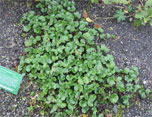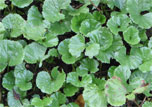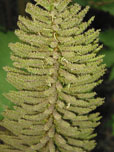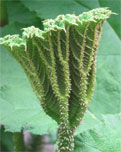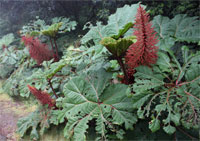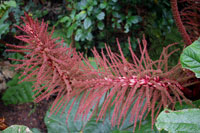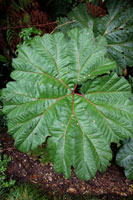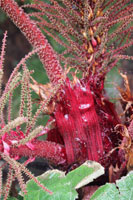|
|
||
This article has been published earlier in the magazine "Hortuskrant" of September 2002
by Fred Triep
| In the context of the theme 'venerable plants' of the September issue of "Hortuskrant", I will give attention at the Giant rhubarb (Gunnera tinctoria). |
|
Giant rhubarb is not of the rhubarb family. Its name derives from its general appearance. In the spring he sprouts and form two-and-half meters high leaves, which resemble those of the rhubarb. The leaf steals have a red to green color. The underside of the leaves and steal are covered with sharp spines.
The genus Gunnera consists of about forty species, mainly originating from temperate to subtropical regions around Antarctica, such as South Africa, South America, Tasmania and New Zealand. Giant rhubarb is found in Chile. Not all species of this genus are the same size. Apart from G. tinctoria also G. manica is large. This is from Colombia and Brazil, and has leaves of three to four meters. G. magellanica also comes from Patagonia, but on the other hand is not greater than ten cm. This plant is a good groundcover in the garden. It is located in the renovated Hemisphere.
By some biologists this genus will be put into a separate family: Gunneraceae. The correct grouping of this genus is still disputed and questioned. By molecular biology research, including at the University of Stockholm, however, one begins to gradually gain insights into the relationships between the individual species.
They are perennials that sprout every year. In June appear plumes that bloom from July to October, with red flowers.
Giant rhubarb likes a moist environment. Therefore, it is often planted around ponds. It can also be planted in drier areas, provided he gets a decent amount of moist and fertile soil for its roots. Giant rhubarb can tolerate frost, but not below minus ten degrees celsius. Therefore, the roots in a Dutch garden are quite covered during winter with leaves. G. tinctoria grows less rapidly than G. manicata, but is preferable for garden lovers. Because he comes from cooler climates, it can better tolerate frost.
Another interesting Gunnera
species is Gunnera insignis.
This species occurs in Central America, from Nicaragua to Colombia. The large
leaves can be used as an umbrella, hence the name "Poor man's umbrella" and
"Sombrilla the pobre".
This plant is mainly found in the mountains, in Costa
Rica between 1000 and 2600 meters.
The plants of the genus Gunnera are of interest for ecologists and physiologists. They seem to have a symbiotic relationship with cyanobacteria of the genus Nostoc. The blue-green algae can fix nitrogen from the air into amino acids and thereby complement the nitrogen cycle on earth with organic nitrogen compounds. The cyanobacteria exchange the nitrogen compounds with their hosts for sugars. A similar symbiotic relationship has been known by legumes, which cooperate with the bacteria in their root nodules.
In the Botanical Garden of Amsterdam (Hortus) you can find the giant rhubarb (Gunnera tinctoria) into the inner curve at the large pond in the back yard. He stands there as early as 1905, but he may be even older. In winter you'll hardly notice it, but by its sheer size you cannot miss this plant in the summer. Probably the famous Dutch botanist Hugo de Vries has been 'looked up' to this plant, as he walked past, when i went form his house near the garden to the buildings.
Literatuur
Vernon Heywood
Bloeiende planten van de wereld
Elsevier, 1979
Livia Wantorp
Phylogeny and Biogeography of the genus Gunnera
http://www.botan.su.se/systematik/folk/Livia.html
Rinus plantenpagina- tuinieren met subtropische planten
Gunnera
http://home.planet.nl/~gerrien/gunnera.htm
Willow Zuchowski
Tropical Plants of Costa Rica- A
guide to native and exotic flora
Zona Tropical Edition of Cornell University
Press, 2007
ISBN 13: 978-0-9705678-4-0
Margaret B. Gargiullo,
Barbara Magnuson en Larry Kimball
A field guide to plants of
Costa Rica
Oxford University Press, 2008
ISBN 13: 978-0-19-518824-0
This page has been completed on
Wednesday 31 augustusi 2016.
![]()
For additions or reactions, send me an e- mail:



